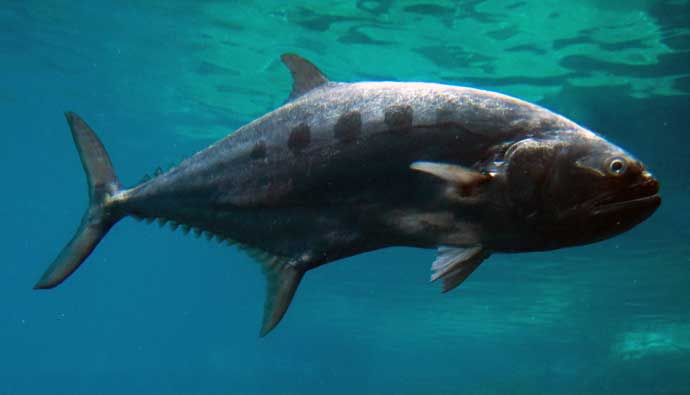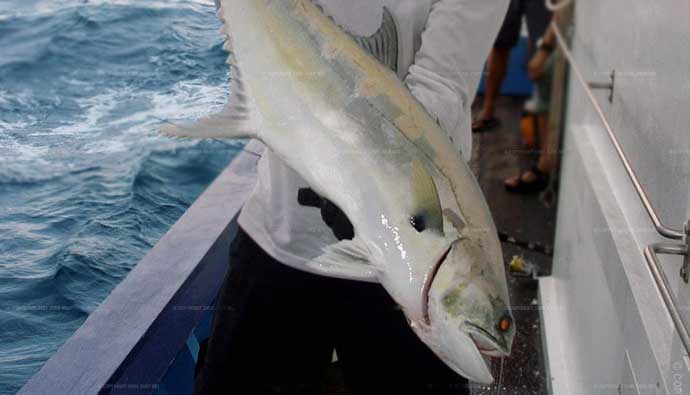The name queenfish is common for a few different species. The one we’re going to cover in this article is the Giant Queenfish (Talang Queenfish), which is a common target in Australia and the South Pacific.
This fish will give you a run for your money on medium tackle.

Let’s get you a big one!
Overview
The queenfish belongs to the drums and croaker family. It can be found in the eastern Pacific Ocean along the North American coastal waters from Oregon to Baja as well as Shark Bay in Western Australia. As tropical sport fish, queenies are powerful and will leap out of the water to throw off the hook or lure.
The body and head of the fish are bluish-black or dusky green in color, and it has a silvery belly. It has 5 to 8 blotches above the lateral line and dark dorsal and anal fins. There are two species of queenfish in Australia, but the large Talang variety provides the best sport.
Queenfish Facts
| Scientific Name | Scomberoides commersonnianus |
| Common Name(s) | Giant Queenfish, leatherskin, queenie, giant dart, and skinny fish, and Talang queenfish. |
| Family | Carangidae |
| Identifying Characteristics | The body and head of the fish are bluish-black or dusky green in color, and it has a silvery belly. It has 5 to 8 blotches above the lateral line and dark dorsal and anal fins. |
| Depth Range | 1 to 100 m |
| Habitat | It can be found in the eastern Pacific Ocean along the North American coastal waters from Oregon to Baja as well Shark Bay in Western Australia. |
| Limits | Check your local regulations |
| Largest Recorded | 39 lbs 7oz caught in South Africa (the average queenfish caught by anglers weigh from 1.7 to 17 lbs) |
| Status | No |
| Diet | mainly feeds on marine invertebrates and small fish |
Queen fish Habitat
Queenies can be found in shallow sand flats that have access to deeper water-rich in baitfish that the fish likes to eat. It also frequents areas around jetties, inshore reef systems, and estuaries. The queenfish can also be found in water that is 100 feet deep, especially when the fish is spawning.
The best time to target them is around the turn of the tide in areas that experience strong currents that cause rips and eddies. The fish tends to move to shallow water as the tide rises.
How to Catch Giant Queenfish

Queenies are powerful and fierce fighters, but they do not head into structures when caught, so you don’t need heavy-duty tackle to catch one. They are available wild-caught. Often, gill nets, by lining and trolling, are the most common ways to catch queenfish.
A rod that works with a 30-50 pound braid will be more than enough for bigger ones. Couple that with a 30-pound leader, and you got yourself a robust system.
This fish will take fish bait, but the best way to catch them is with lures such as stickbaits and poppers. Yet, you can also use soft plastics, lead head jigs, and small metals. If the kingfish only darts around the lures and don’t strike, change tactics.
Talang Queenfish Fishing Tactics
- If you are fishing with lures, make sure it is always in motion, or the queen will lose interest. When you catch one, reel it in fast before it starts fighting, or you will have a long and tiring day ahead of you.
- Don’t slow your lures. Keep them moving fast for more hookups.
Giant Queenfish Fishing Tips
- When you are looking for talang, look for heavy currents in the water to find them, such as the mouths of rivers. You can use a variety of lures as long as they are used quickly.
- The livelier the baitfish you use to catch queenfish, the better.
Spearfishing for Queenfish

- If you are spearfishing for queenies in the shallows, make sure that the weights you have on enable your natural buoyancy when you are at rest so you don’t spook the fish by swimming too fast.
- A double-banded gun with a flopper should be more than enough to bring one in.
Queenfish Seasons
If you want to catch queens in Australia, make plans for a fishing trip in the months between June and October. You can also fish in November, December, April, and May, but you will find fewer queens during those months and none in January, February, and March.
How to Clean Giant Queenfish
- Place the queenie on a clean cutting board.
- Use sharp kitchen shears to cut off all of the fins.
- Turn the fish on its back and use a sharp knife to cut off the head, so that you are left with a V-shaped cavity where the head was.
- Make the cavity bigger by snipping at the belly and taking out the guts using your fingers.
- Clean the fish thoroughly to remove all traces of blood and guts.
- Cut off the tail with the kitchen shears.
- Use a sharp knife to slice the body in half to get two fillets.
Queenfish Recipe
- Cut the queenfish fillets into thin strips and mix it in the juice of 4 limes. Lime juice is acidic, so it will cook the fish.
- Place the fish in a large bowl.
- Add salt and fresh chili to taste, some olive oil, and coriander.
- Mix well before placing it in the fridge for a few hours.
- Serve on fresh lettuce.
Frequently Asked Questions
It feeds on marine invertebrates and small fish such as anchovy as well as crustaceans.
Queenfish can grow to weigh as much as 33 lbs, but most only grow to about half that size.
The fish is abundant in Australia since it does not have a lot of commercial value, but if you want to target the big ones for sport, head for North Queensland.
Insider Advice
Queenfish can be difficult to take alive because of the sharp spines they have and especially if they are caught in a light tackle. Make sure you have thick gloves on to prevent painful injuries.
When you are able to catch one, use its shiny skin to make reflective lures.
Fun Fact! The USS Queenfish was the United States Navy’s first ship to be named after the queenfish. After its World War II service, it served as Flagship Submarine Force, Pacific Fleet, and was homeported at Pearl Harbor before later transferring to San Diego.




 Facebook
Facebook YouTube
YouTube








